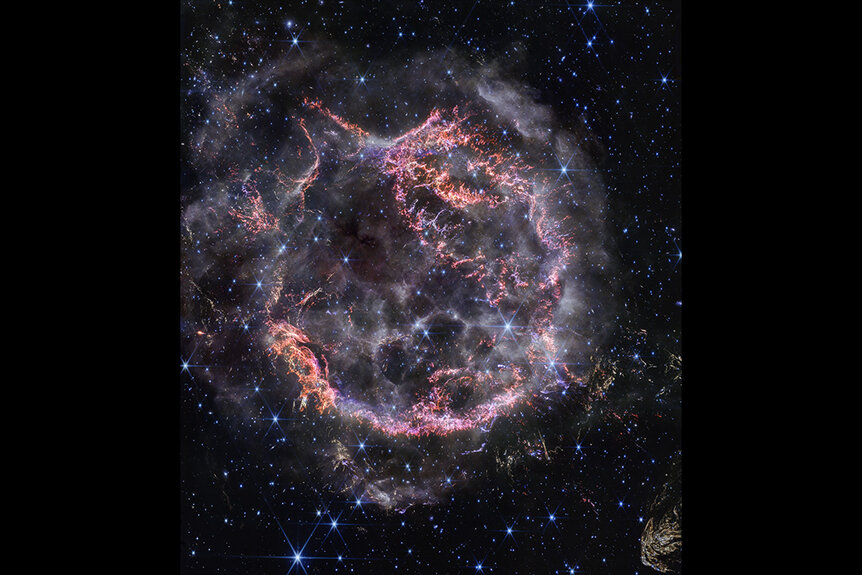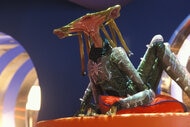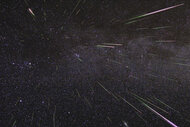Create a free profile to get unlimited access to exclusive videos, sweepstakes, and more!
JWST Unveils Cosmic "Christmas Ornament" Supernova, Just in Time for the Holidays
Like a trillion distant Christmas bulbs, lighting up the sky.

Few people have had a stronger influence on popular culture than Theodore Geisel, writing under the pseudonym Dr. Seuss. His books are some of the first that many kids read, and his wacky works have been reprinted, translated, and adapted to screen countless times. You can’t throw a roast beast without hitting a Seussian reference, but one story stands above the rest, especially this time of year.
The holiday classic How the Grinch Stole Christmas! is a rollercoaster ride of emotion. It follows the titular Grinch, an unfortunate, green-furred fellow with a congenital heart defect. For reasons which aren’t wholly explained, the Grinch was born with a heart two sizes too small. He’s lucky to be alive and hating holiday fun.
RELATED: How the Grinch Stole Christmas! 5 Things You Didn’t Know About Dr. Seuss’ Yuletide Classic
The precise location and nature of Whoville (alternatively Who-Ville) varies. Sometimes it’s in a snowflake (the live action film) and sometimes it’s in a dust mote (Horton Hears a Who). Sometimes Whoville is just Whoville, like in the 2018 animated adaptation, simply titled The Grinch, streaming now on Peacock. Might we suggest that Whoville exists someplace else entirely, perhaps inside the distant supernova remnant Cassiopeia A.
JWST Reveals Supernova Cassiopeia A Like Never Before
Cassiopeia A (Cas A) is the shattered remains of a long-dead star, located about 11,000 light-years from here. Despite that great distance, Cas A still lies within our own galaxy, in the next galactic arm over. It’s believed to have first shown up in the night sky at the end of the 17th century, but we’re not quite sure. Regardless, it has been fascinating astronomers for years, prompting observations from just about every telescope we have. Now, astronomers are using NASA’s James Webb Space Telescope (JWST) to capture never-before-seen details.
JWST first turned its attention toward Cas A in early 2023, using the telescope's Mid-Infrared Instrument (MIRI). More recently, astronomers imaged the supernova again, this time using JWST’s Near Infrared Camera (NIRCam). The resulting image is revealing new data about one of the most well-studied objects in the sky, and it’s gorgeous to boot.
New details emerge around the expanding shell of the nova remnant. Before the origin star exploded, during the final phases of its life, it shed a bunch of gas out into the surrounding space. Later, when the star exploded, it cast the remainder of its material out into the same space. Today, that shell is expanding from the point of explosion and slamming into the gas and dust the star expelled all those years ago. At the interface of those interactions, charged particles spin around magnetic field lines and generate synchrotron radiation. You can see it painted white in the image. Other bits of the nova’s inner shell show up in oranges and pinks, indicating the sulfur, oxygen, argon, and neon found there.
RELATED: Hubble and JWST Join Forces to Create Most Colorful View of the Cosmos Ever
“With NIRCam’s resolution, we can now see how the dying star absolutely shattered when it exploded, leaving filaments akin to tiny shards of glass behind. It’s really unbelievable after all these years studying Cas A to now resolve those details, which are providing us with transformational insight into how this star exploded,” said Danny Milisavljevic, lead researcher on the project, in a statement.
In addition to sparking new scientific inquiry and adding to our understanding of the universe, the image was included in the first ever White House Advent Calendar as part of the 2023 Holidays at the White House, according to NASA. While Cas A has been widely studied, it will likely continue to reveal new information to us as it keeps expanding into the surrounding space. It’s getting bigger all the time, not unlike the Grinch’s shriveled little heart.
We’re not sure where Whoville or The Grinch is, but we know you can find them streaming right now on Peacock.














